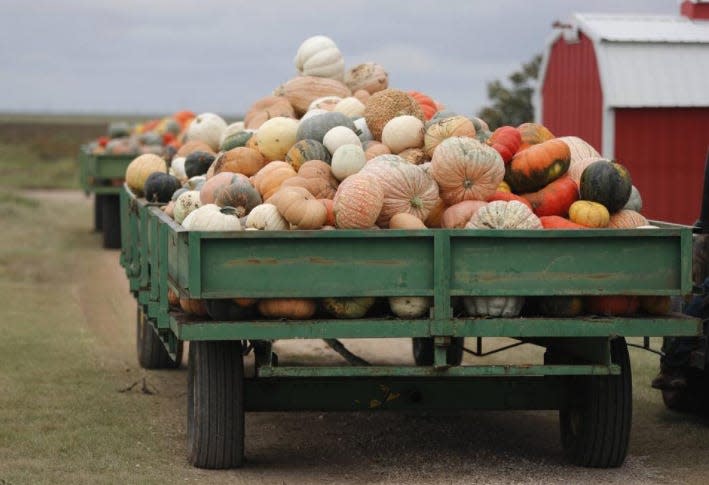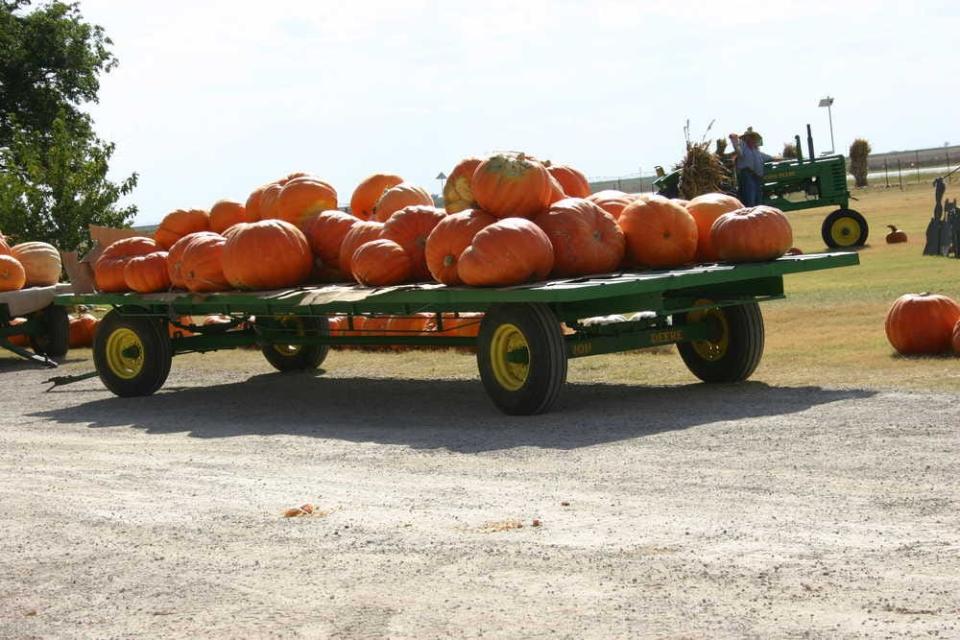Growing the 'Gourd' Standard: Floydada festival celebrates High Plains pumpkin greatness

FLOYDADA - All things pumpkin were in vogue as thousands flocked to the downtown square of this Floyd County community on Saturday morning, where residents, visitors and vendors alike gathered to celebrate the community's 35th annual Punkin Days festival.
But Saturday's annual event represents more than one small town's celebration of a popular, seasonal gourd.
Despite the below-average harvest that the crop saw this year, the High Plains of West Texas and Eastern New Mexico has continued to embrace with open arms what's become a potent, signature crop of the region.
Every year, gourds of all variations and decorated jack-o’-lanterns paint Floydada orange - and a surprising variety of other colors - throughout the month of October.
Small pumpkins decorate the city's welcome sign and nearby homes and businesses. Statue-sized pumpkins adorn the parking lots of the local grocery store, car wash and hardware shop. And large banners and signs around the city proudly tout Floydada's biggest accomplishment: Recognition as the “Pumpkin Capital of the US.”
For many, it comes as a surprise that the small Floyd County seat of 2,700 people just northeast of Lubbock has established such a unique identity. Whereas Illinois produces around 90% of the nation’s pumpkin crop, Floydada has become famous for boasting its gourd greatness.
“Floydada ships out pumpkins all over the United States,” said Kalli Martin, president of the Floydada Chamber of Commerce and Agriculture’s Board of Directors. “We are one of the largest pumpkin carriers for the southern part of the United States. We have been growing pumpkins for decades, and we have been the Pumpkin Capital for about 30 years, and we’re proud of it."
Home to the Pumpkin Pyle farm and Assiter ‘Punkin’ Ranch, the immediate area typically grows around 1,200 acres of pumpkins annually. In fact, the entire High Plains region — spanning 41 counties — has made a name for itself in the pumpkin industry since one Floydada family planted five acres of pumpkins and sold them roadside in the 1950s.
Now, the entire High Plains region produces between 4,000 to 7,000 acres of pumpkins, annually, and has become the gourd standard for Halloween jack-o’-lanterns. And on any given label slapped upon a jack-o’-lantern from the local grocery store, it’s more likely than not to list its home producer as somewhere local: Dalhart, Floydada, Muleshoe or Clovis, New Mexico.
As the pumpkin harvest in our region comes to a close this week, Mark Carroll, the Texas A&M AgriLife Extension agriculture agent in Floyd County, anticipates below-average yields for the second consecutive harvest.
While wet and rainy conditions yielded a crop 30% below average last year, this year’s culprit is the months-long drought, whose actual impact is still in the air, though like other regional crops that have suffered, experts do know that loss was inevitable.
Withstanding extreme heatwaves and dry conditions for the first couple months of growing season, Carroll said the success of local producers varied this year. Some, who had ample irrigation were able to improve year-over-year production between 10 to 20%, while others reported yields even lower than last.

“We had virtually no rainfall this summer, so the crop relied entirely on irrigation,” Carroll said in a release from the AgriLife Extension. “Getting the crop well established was an issue, but by July most fields looked good, because pumpkins do really well in the heat.”
In the drizzly, cold weather mid-morning Saturday, dozens of cars had stopped by the Assiter Punkin Ranch on their way into town. Surrounded by nothing but cotton farms along Highway 62, just on the edge of the Floyd-Crosby County border, dozens of pumpkins lined the fences — and an empty, mostly harvested field stood to the south.
Tim Assiter, the head of the family pumpkin ranch, is a second-generation pumpkin farmer, the Lubbock Avalanche-Journal reported in a previous story. His father learned the notable trade from the city's pumpkin pioneer — “Uncle Slim” Robertson, known as the “Original Floydada Pumpkin Man,” who built the unique brand for his hometown.
Due to his drip irrigation lines, Assiter managed to escape the scene of a completely decimated crop that other area farmers (of various crops) have faced this year, he told KWES-TV in Midland earlier this week.
With more than 170 pumpkin variants on his farm, Assiter told the station that the greater Floydada region brings between 1.8 million and 2.4 million pumpkins to the global supply each year. (Although he told KWES-TV that wouldn't actually commit to providing a numerical estimate, the math he provides equated to this range.)
In its prime, Floydada pumpkin farmers existed in the dozens with at least 35 farmers across 3,000 acres in 1993, he said.
“Today, we have about 1,200 acres (and fewer growers), but we raised about the same amount,” he said. “(Floydada) is a great place to grow pumpkins — we grow them here, and we grow a lot of them.”
This article originally appeared on Lubbock Avalanche-Journal: High Plains farmers grow the 'gourd' standard for jack-o'-lanterns
